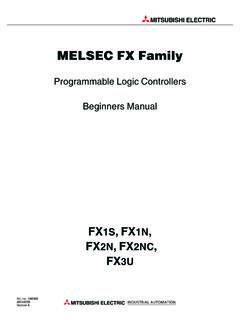Transcription of POWER FREQUENCY CONTROL
1 POWER FREQUENCY CONTROL _____ 1 POWER FREQUENCY CONTROL 1. INTRODUCTION 2 2. SMALL SIGNAL ANALYSIS OF POWER SYSTEMS 5 3. STATIC PERFORMANCE OF SPEED CONTROL 6 4. THE POWER SYSTEM MODEL 8 5. THE RESET LOOP 11 6. POOL OPERATION 14 7. STATE-SPACE REPRESENTATION OF A TWO AREA SYSTEM 19 REFERENCES 23 POWER FREQUENCY CONTROL _____ 2 1. Introduction The general requirements for the operation of a POWER network are that the FREQUENCY and voltage be maintained within designated limits.
2 FREQUENCY is a system-wide parameter in the steady state as a system (or a number of interconnected systems) has the same FREQUENCY throughout. Voltage varies considerably within a POWER network and depends on the loading. Typically, the limits for FREQUENCY variation are ( in a 50Hz system or a FREQUENCY band of ). This is the normal range for the Irish system1. The range during transmission disturbances is 48Hz to 52Hz and during exceptional transmission disturbances is 47Hz to 52Hz. The permissible variation in voltage is much greater, typically 6%.
3 As has been seen from load flow analysis, there is a strong correlation between load or rotor angle (and hence FREQUENCY ) and active POWER and between voltage and reactive POWER . f P V Q Essentially, FREQUENCY in a POWER system is controlled by ensuring that the injected POWER (from the connected generators) matches the system load, with all losses taken into account. Voltage is controlled by the injection of reactive POWER to meet the reactive demand, together with other measures such as transformer tap changing and automatic voltage regulator (AVR) action.
4 Figure 1 shows the AVR and turbine CONTROL loops in a generation station. Figure 1 AVR and Turbine CONTROL Loops 1 Grid Code, POWER FREQUENCY CONTROL _____ 3 This section considers the CONTROL of FREQUENCY in a POWER system and the effect of interconnection to other systems on POWER flows and FREQUENCY . The system FREQUENCY is determined by the speed of rotation of the generators in the system, which in turn is determined by the balance between generator and load POWER ; essentially the balance between input and output POWER .
5 Figure 2 shows a schematic representation of a fossil fuel fired boiler/turbine/generator. The voltage and speed CONTROL inputs can be identified. Figure 2 Fossil fired drum boiler/turbine/generator schematic diagram Voltage CONTROL is considered separately. We can say that there are two CONTROL loops in a POWER system: the automatic load FREQUENCY CONTROL loop (ALFC) and the automatic voltage CONTROL loop (AVR). There is little interaction from the ALFC loop to the AVR loop but the AVR loop does affect the ALFC loop to a certain extent.
6 The AVR loop tends to be much faster than the ALFC loop with time constants of much less than one second. POWER FREQUENCY CONTROL _____ 4 Automatic Generation CONTROL Turbine/Generator Intertia Electrical System (a) Generators (b) Networks (c) Loads Governor Speed Changer Speed Governor Speed CONTROL Mechanism Governor-Controlled Valves or Gates Turbine Assigned Unit Generation Interchange POWER FREQUENCY Turbine and Energy System Speed-Governing System Angle Speed Electrical POWER Mechanical POWER Figure 3 Location of speed-governing system and turbine relative to complete system [5] Figure 4 Typical response times of some CONTROL functions Figure 3 shows the location of the speed-governing system and the turbine relative to the complete system.
7 As can be seen, the angle and speed is determined by the difference between the electrical and mechanical POWER , acting on the inertia of the turbine/generator combination. The speed and the assigned unit generation determine the mechanical POWER being produced by the turbine. The angle of the generator (in combination with the network, generator and loads) determines the electrical POWER output. The automatic generation CONTROL system determines the assigned unit generation. POWER FREQUENCY CONTROL _____ 5 Figure 4 shows the typical response times of some CONTROL functions within the POWER network.
8 The high-speed excitation and governing CONTROL functions can be identified on the left of the diagram with response times between 1 and 10 seconds. The response times to system faults by protection systems will be faster than this characteristic time in the range of multiples of POWER cycles, up to second. 2. Small Signal Analysis of POWER Systems Analysis of POWER networks can be divided into small-signal and large-signal analysis. For the time-domain analysis of events, such as major faults where voltages can change by up to 100%, large-signal analysis is required.
9 For small changes, where the response can be considered linear over the typical range, small-signal or linear analysis can be used. Hence the Laplace transform can be used to consider the time domain and FREQUENCY domain response of such linear systems. POWER FREQUENCY CONTROL in POWER systems is usually investigated using linear or small-signal methods. Figure 5 POWER CONTROL mechanism [1] Figure 5 shows a physical representation of an automatic load FREQUENCY CONTROL system for a turbine/generator. This analysis is taken from Elgerd s book [1]. The actual CONTROL system on a modern generator would be quite different to that shown here but the system in Figure 5 is useful for the purposes of illustration.
10 The aim is to maintain the desired MW output of the generator and the rated FREQUENCY by controlling the POWER to the turbine. This in turn is determined by the position of the valve (steam or water). The POWER output is changed by changing the reference POWER (speed changer) which indirectly changes the speed. The speed (and hence FREQUENCY ) is measured by the speed governor. The pressure on the valve and hence position of the main piston is proportional to the fluid into the hydraulic amplifier. The position of the valve (in the Laplace domain is given by): POWER FREQUENCY CONTROL _____ 6 += )(1)(1)(sFRsPsTKsxCGGe ( ) R is in Hz/MW and is referred to the regulation or droop.



